[ad_1]
Reasons for Caution:
Tech stocks are getting hit by the China trade war. Bank stocks are lagging on worries about refinancing of corporate bonds. The energy sector is slumping as crude oil declines. Retail stocks have been taken to the woodshed on concerns of increasing costs due to tariffs.
Uncertain monetary policy is another concern as quantitative tightening continues. When the Federal Reserve unwinds its balance sheet, money is drained from the banking system. The Fed reduced their balance sheet by $27 billion during the week ended on May 15. During the week of May 22, another $5 billion reduction occurred.
On May 22, the balance sheet was marked at $3.860 trillion, down $640 billion since the end of September 2017 when quantitative tightening began. The unwinding will not meet Fed Chairman Jerome Powell’s stated goal of a $3.5 trillion balance sheet.
Here’s Today’s Scorecard
SPDR Dow Jones Industrial Average ETF (NYSEARCA:DIA)
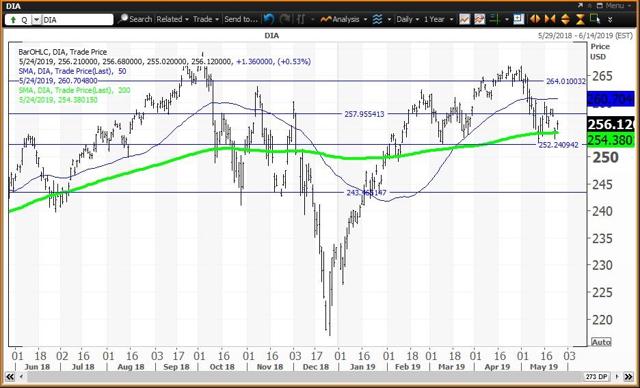 Courtesy of Refinitiv XENITH
Courtesy of Refinitiv XENITH
The Diamonds ETF is 18% above its 2018 low of $216.97 set on Dec. 26 and is 4.9% below its all-time intraday high of $269.28 set on Oct. 3. The all-time closing high is $267.67 also set on Oct. 3. The 2019 high remains at $266.86 set on April 23. Remember that Dec. 26 low was a positive “key reversal” day as the close was above the Dec. 24 high.
Diamonds is below its five-week modified moving average at $259.70 with its 12x3x3 weekly slow stochastic reading falling to 64.42 last week, down from 78.00 on May 17 as the “inflating parabolic bubble” has popped. Monthly and semiannual value levels are $252.22 and $243.47, respectively, with an annual pivot at $257.94 and weekly and quarterly risky levels at $264.01 and $279.04, respectively.
SPDR S&P 500 Trust ETF (NYSEARCA:SPY)
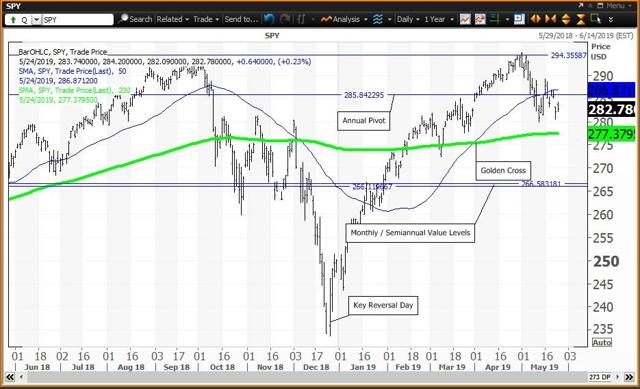 Courtesy of Refinitiv XENITH
Courtesy of Refinitiv XENITH
The Spiders ETF remains in bull market territory 21% above its Dec. 26 low of $233.76 and is 4.1% below its all-time intraday high of $294.95 set on May 1. The all-time closing high was set at $294.34 on April 30. Remember that Dec. 26 was a “key reversal” day as the close was above the Dec. 24 high.
Spiders is below its five-week MMA at $286.04 with its 12x3x3 weekly slow stochastic reading dipping to 77.76 last week, down from 87.45 on May 17 and now below 90.00 which is the threshold of being in an “inflating parabolic bubble.” The bubble is popping. Monthly and semiannual value levels are $266.58 and $266.14, respectively, with an annual pivot at $285.86 and weekly and quarterly risky levels at $294.37 and $297.56, respectively.
Invesco QQQ ETF (NASDAQ:QQQ)
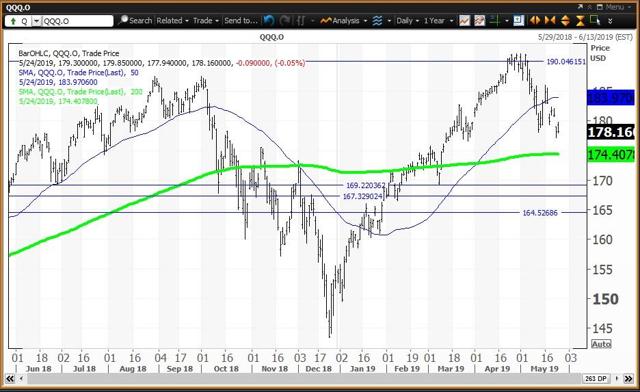 Courtesy of Refinitiv XENITH
Courtesy of Refinitiv XENITH
The QQQ ETF remains in bull market territory 24.2% above its 2018 low of $143.46 on Dec. 24. QQQ is 6.9% below its all-time intraday high of $191.32 set on May 1. The all-time closing high is $191.11 on May 3.
QQQ is below its five-week MMA at $182.73 with its 12x3x3 weekly slow stochastic reading slipping to 78.41 last week, down from 88.66 on May 10. QQQ had a reading above 90.00 as an “inflating parabolic bubble” which is popping. Annual, semiannual and monthly value levels are $169.27, $167.53 and $164.31, respectively, with weekly and quarterly risky levels at $190.01 and $194.29, respectively.
iShares Transportation Average ETF (NYSEARCA:IYT)
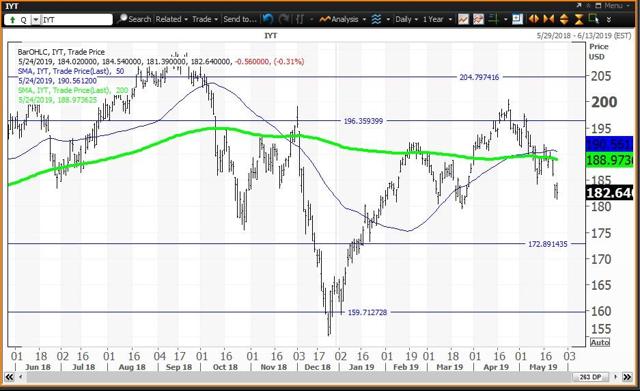 Courtesy of Refinitiv XENITH
Courtesy of Refinitiv XENITH
IYT is 17.7% above its 2018 low of $155.24 set on Dec. 24. The ETF is in correction territory 12.8% below its all-time intraday high of $209.43 set on Sept. 14. The closing high of $208.48 was set the same day. The 2019 high of $200.42 was set on April 24.
IYT is below its five-week MMA at $189.68 with its 12x3x3 weekly slow stochastic reading slipping to 62.95 last week, down from 75.39 on May 17. Monthly and semiannual value levels are $172.90 and $159.63, respectively, with annual and quarterly risky levels at $196.35 and $204.78, respectively.
iShares Russell 2000 ETF (NYSEARCA:IWM)
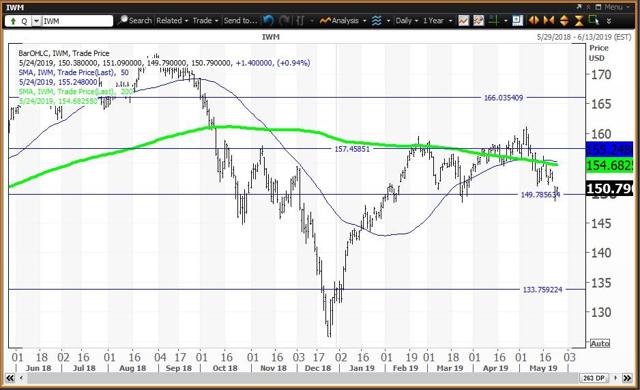 Courtesy of Refinitiv XENITH
Courtesy of Refinitiv XENITH
IWM is 19% above its 2018 low of $125.81 set on Dec. 26 and is in correction territory 13% below its all-time intraday high of $173.39 set on Aug. 31. The all-time closing high at $173.02 was set the same day. The 2019 high is $161.11 set on May 6.
IWM is below its five-week MMA at $154.64 with its 12x3x3 weekly slow stochastic reading falling to 65.07 last week, down from 77.88 on May 17. My monthly value level is $133.78 with a semiannual pivot at $149.77, an annual pivot at $157.49 and quarterly risky level at $166.03.
How to use my value levels and risky levels:
Value levels and risky levels are based upon the last nine weekly, monthly, quarterly, semiannual and annual closes. The first set of levels was based upon the closes on Dec. 31. The original semiannual and annual levels remain in play. The weekly level changes each week; the monthly level was changed at the end of January, February, March and April. The quarterly level was changed at the end of March. My theory is that nine years of volatility between closes are enough to assume that all possible bullish or bearish events for the stock are factored in. To capture share price volatility, investors should buy on weakness to a value level and reduce holdings on strength to a risky level. A pivot is a value level or risky level that was violated within its time horizon. Pivots act as magnets that have a high probability of being tested again before its time horizon expires.
How to use 12x3x3 Weekly Slow Stochastic Readings:
My choice of using 12x3x3 weekly slow stochastic readings was based upon back-testing many methods of reading share price momentum with the objective of finding the combination that resulted in the fewest false signals. I did this following the stock market crash of 1987, so I have been happy with the results for more than 30 years. The stochastic reading covers the last 12 weeks of highs, lows and closes for the stock. There is a raw calculation of the differences between the highest high and lowest low versus the closes. These levels are modified to a fast reading and a slow reading and I found that the slow reading worked the best. The stochastic reading scales between 00.00 and 100.00, with readings above 80.00 considered overbought and readings below 20.00 considered oversold. Recently, I noted that stocks tend to peak and decline 10% to 20% and more shortly after a reading rises above 90.00, so I call that an “inflating parabolic bubble” as a bubble always pops. I also call a reading below 10.00 as being “too cheap to ignore.”
Disclosure: I/we have no positions in any stocks mentioned, and no plans to initiate any positions within the next 72 hours. I wrote this article myself, and it expresses my own opinions. I am not receiving compensation for it (other than from Seeking Alpha). I have no business relationship with any company whose stock is mentioned in this article.
[ad_2]
Source link Google News


